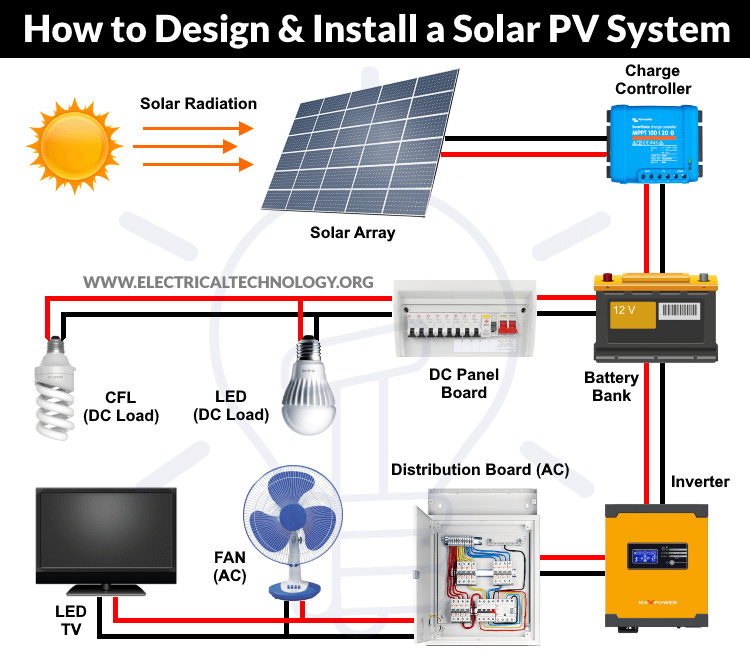What is solar PV system?
Solar photovoltaic system or Solar power system is one of renewable energy system which uses PV modules to convert sunlight into electricity. The electricity generated can be either stored or used directly, fed back into grid line or combined with one or more other electricity generators or more renewable energy source. Solar PV system is very reliable and clean source of electricity that can suit a wide range of applications such as residence, industry, agriculture, livestock, etc.
Major system components
Solar PV system includes different components that should be selected according to your system type, site location and applications. The major components for solar PV system are solar charge controller, inverter, battery bank, auxiliary energy sources and loads (appliances).
��� PV module � converts sunlight into DC electricity.
��� Solar charge controller � regulates the voltage and current coming from the PV panels going to
battery and prevents battery overcharging and prolongs the battery life.
��� Inverter � converts DC output of PV panels or wind turbine into a clean AC current for AC
appliances or fed back into grid line.
��� Battery � stores energy for supplying to electrical appliances when there is a demand.
��� Load � is electrical appliances that connected to solar PV system such as lights, radio, TV, computer,
refrigerator, etc.
��� Auxiliary energy sources - is diesel generator or other renewable energy sources.
Solar PV system sizing
1. Determine power consumption demands 1.1 Calculate total Watt-hours per day for each appliance used.
Add the Watt-hours needed for all appliances together to get the total Watt-hours per day which
must be delivered to the appliances.
1.2 Calculate total Watt-hours per day needed from the PV modules.
Multiply the total appliances Watt-hours per day times 1.3 (the energy lost in the system) to get
the total Watt-hours per day which must be provided by the panels.
2.1 Calculate the total Watt-peak rating needed for PV modules
Divide the total Watt-hours per day needed from the PV modules (from item 1.2) by 3.43 to get
the total Watt-peak rating needed for the PV panels needed to operate the appliances.
2.2 Calculate the number of PV panels for the system
Divide the answer obtained in item 2.1 by the rated output Watt-peak of the PV modules available
to you. Increase any fractional part of result to the next highest full number and that will be the
number of PV modules required.
3. Inverter sizing
4. Battery sizing
4.1 Calculate total Watt-hours per day used by appliances.
4.2 Divide the total Watt-hours per day used by 0.85 for battery loss.
4.3 Divide the answer obtained in item 4.2 by 0.6 for depth of discharge.
4.4 Divide the answer obtained in item 4.3 by the nominal battery voltage.
4.5 Multiply the answer obtained in item 4.4 with days of autonomy (the number of days that you
need the system to operate when there is no power produced by PV panels) to get the required
Ampere-hour capacity of deep-cycle battery.
Battery Capacity (Ah) = Total Watt-hours per day used by appliances x Days of autonomy
(0.85 x 0.6 x nominal battery voltage)
Remark: For MPPT charge controller sizing will be different. (See Basics of MPPT Charge Controller)
Example: A house has the following electrical appliance usage:
- One 18 Watt fluorescent lamp with electronic ballast used 4 hours per day.
- One 60 Watt fan used for 2 hours per day.
- One 75 Watt refrigerator that runs 24 hours per day with compressor run 12 hours and off 12 hours.
The system will be powered by 12 Vdc, 110 Wp PV module.
1. Determine power consumption demands
| Total appliance use = (18 W x 4 hours) + (60 W x 2 hours) + (75 W x 24 x 0.5 hours) | |
| = 1,092 Wh/day | |
| Total PV panels energy needed | = 1,092 x 1.3 |
| = 1,419.6 Wh/day. | |
2. Size the PV panel
| 2.1 Total Wp of PV panel capacity needed |
= 1,419.6 / 3.4 |
| = 413.9 Wp | |
| 2.2 Number of PV panels needed | = 413.9 / 110 |
| = 3.76 modules |
Actual requirement = 4 modules
So this system should be powered by at least 4 modules of 110 Wp PV module.
3. Inverter sizing
Total Watt of all appliances = 18 + 60 + 75 = 153 W
For safety, the inverter should be considered 25-30% bigger size.
The inverter size should be about 190 W or greater.
4. Battery sizing
Total appliances use = (18 W x 4 hours) + (60 W x 2 hours) + (75 W x 12 hours)
Nominal battery voltage = 12 V
Days of autonomy = 3 days
Battery capacity = [(18 W x 4 hours) + (60 W x 2 hours) + (75 W x 12 hours)] x 3
(0.85 x 0.6 x 12)
Total Ampere-hours required 535.29 Ah
So the battery should be rated 12 V 600 Ah for 3 day autonomy.
5. Solar charge controller sizing
PV module specification
Pm = 110 Wp
Vm = 16.7 Vdc
Im = 6.6 A
Voc = 20.7 A
Isc = 7.5 A
Solar charge controller rating = (4 strings x 7.5 A) x 1.3 = 39 A
So the solar charge controller should be rated 40 A at 12 V or greater.



